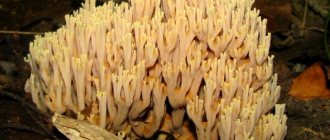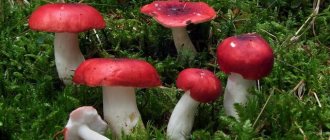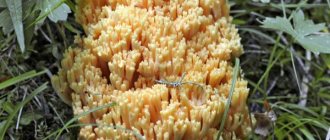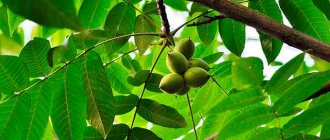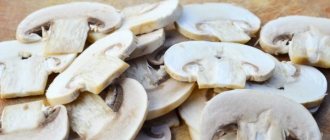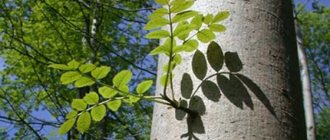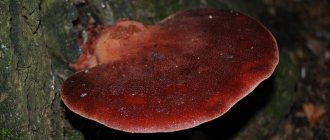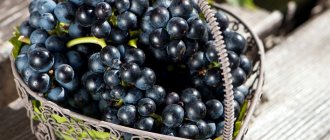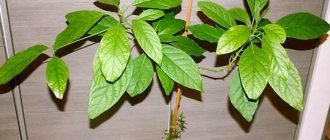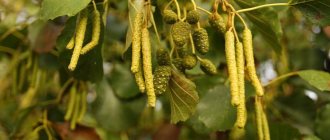Mushrooms
0
2041
Article rating
Kira Stoletova
The mushroom kingdom is distinguished by a great diversity of representatives. They have different properties and appearance, sometimes very bizarre. These include the horned mushroom, which, due to its unusual appearance, is popularly called “deer horns.”
Features of the horned mushroom
Botanical characteristics
It is a close relative of chanterelles. It differs from other genera in the kingdom of mushrooms in the special structure of the fruiting body, which in most varieties has a highly branched structure with a clearly defined mushroom stalk.
- Fruiting body: according to its appearance, it is conventionally divided into groups (coral-shaped branched, club-shaped and awl-shaped). The structure of the branches is branched, divided into two parts, interconnected internally. This type of branching is called dichotomous. Both parts are almost equal in height, growing almost in a parallel direction. The color of the fruiting body varies: white, cream, pale yellow, brown or brown. When mechanically applied (pressure), it changes color to burgundy-red.
- Mushroom stem: depending on the type, the diameter of the mushroom stem can vary up to 1-2 cm, with a height of 6-25 cm. The color is pale yellow, some mushrooms have a purple tint. In many species, in the base area there is often a noticeable accumulation of mycelial hyphae or there are thread-like mycelial strands composed of parallel hyphae partially fused together in the longitudinal direction.
Edibility
According to the general classification, it is classified as inedible. The taste is bitter, peppery. Only a few varieties are conditionally edible and can be used for food purposes, but they have a low nutritional value class.
Area
The habitats cover the Eurasian continent and the North American continent. It grows everywhere in Russia, especially in the Far Eastern regions and European regions.
Among its habitats, it prefers coniferous and mixed forest belts, where pine and spruce trees predominate. It is more often found on rotting wood debris, less often growing on the surface of the ground in the bush area.
Description
Rogatiki are mushrooms that are very different in appearance from other representatives of this kingdom. They do not have a clearly defined stem and cap, the fruit body is homogeneous - club-shaped or awl-shaped. Some varieties have a branched structure, similar to corals.
Rogatik pistil is an elongated mushroom, its height can be 15-30 cm. It is large, light yellow in color, and cylindrical in shape. Narrow at the bottom, widening at the top, shaped like a mace or pestle. The apex is smoothed, semicircular. The width reaches 5 cm.
The pulp is like a sponge, easily compressed, porous, and denser in young fruits. The spores are white or slightly yellowish and are located on the surface. The skin is smooth, light, pleasant to the touch. The flesh turns red when touched and quickly darkens when cut. With age, grooves form on the fruiting body. The pulp becomes bright yellow, dark or orange in older fruits.
Varieties
Rogatik straight
The straight horned mushroom has another name - straight or hard ramaria. This is an inedible mushroom, the fruiting body of which reaches 1.5-6 cm in diameter. In appearance, it resembles a bush of vertically growing straight branches with a clearly visible stem. The color is pale, ocher-yellow or brown. At the base of the stalk, a cluster of white mycelium is clearly visible.
The structure of the mushroom pulp in young ramaria is fragile, in adults it is hard and resembles rubber. The color is light. There is no smell. The taste is bitter, slightly peppery, but the smell is pleasant.
Distributed in coniferous forests. Grows on litter. Fruiting begins in July and lasts until October. The peak of ramaria activity occurs in August-September.
Rogatik reed
Rogatik reed, or clavariadelphus reed, mace, pistil, belongs to the edible varieties.
The fruit body, 0.5-3 cm in diameter, is club-shaped and has no branching. The color is yellow with a slight orange tint or cream. The mushroom stalk tapers towards the base.
The mushroom pulp of young specimens is spongy, elastic, white, while in adult mushrooms it is dry and brittle. There is no smell.
Height 5-8 cm. Grows in a group of fruiting bodies pressed against each other. The surface is initially smooth, but wrinkles over time. The internal structure is hollow.
():
The fruiting body of Horntail reed is characterized by the complete absence of a cap and stem. Fruiting bodies may press against each other during development. Their base is pubescent, resembling felt. Young bodies are cream or yellow, then the color becomes ocher-yellow, and mature ones are brown with a purple tint. This purple tone is noticeable at the base of the mushroom.
The structure of the horned flesh changes with age: from soft, spongy to dry and brittle. A purple tint appears when cut or broken. Although the mushroom has no taste or smell as such, it can still be bitter.
Clubworts are found in fairly large groups - up to a hundred or more. This species is widespread in all forest zones in the post-Soviet space.
It grows mainly among coniferous trees (spruce, pine) in the litter, among moss and in fallen pine needles. Fruiting begins in July and lasts until November. Peak activity occurs in October.
The horn is beautiful
Rogatik Beautiful is poisonous
According to the description, the beautiful hornet, or beautiful ramaria, is a poisonous mushroom. The fruiting body is 5-15 cm in diameter. Height is 10-25 cm. The color of the fruiting body combines three tones - white, yellow and pink. The mushroom base is short and massive. In young specimens it is bright pink, but in older specimens it is white.
Formed in the form of a bush from numerous branches forked or dissected at the ends.
The mushroom pulp is fragile, white-cream. There is no smell. When subjected to mechanical action, it acquires a reddish tint.
Grows in deciduous and mixed forest belts, mainly under beech. Fruiting begins in the mud and lasts until November. inclusive. Peak activity occurs in September.
Rogatik comb
Rogatik comb, or clavulina comb, is a little-known edible mushroom. The fruiting body is divided into flattened branches, split at the ends into thin and short, seemingly sharp teeth, folding into ridges. It was this structural feature that gave the mushroom its specific epithet - comb, which is written in Latin as cristata.
Height 2-6 cm. Color white, creamy, sometimes fawn. The structure of the mushroom pulp is soft and fragile. There is no smell or taste, sometimes there may be a bitter aftertaste.
It grows in deciduous and coniferous forest belts in large groups, mainly in a ring shape, in fallen leaves, on the ground and in grass. Fruiting begins in July and lasts until October. Peak activity occurs at the end of August - mid-September.
How to cook horned mushrooms
Due to the structural features of the fungus, quite a lot of dirt and debris accumulates between the fruiting bodies. Therefore, before cooking, they need to be washed for a long time and thoroughly in running water. After this, the cattails are boiled for half an hour in water with added salt. The water is drained, the mushrooms are washed and re-cooked in salted water for another 15-20 minutes. Then the water is drained.
Now they can be eaten. They are usually fried with vegetables, sometimes used as an ingredient in mushroom soup or sauce.
Important! The aroma of horned mushrooms is quite subtle, so you should not use large amounts of aromatic herbs or spices in prepared dishes.
Practical use
Rogatiki have found their practical application in cooking and medicine.
Cooking
The reed and comb horntails belong to conditionally edible species with low gastronomic qualities of category 4, because their flesh is often bitter. They are not mass produced. It is recommended to collect only young specimens.
The advantage of edible cattails over others is that they are not affected by worms.
Bitterness is removed by prolonged soaking in cold water (for 10-12 hours) followed by heat treatment or salting. The duration of pre-boiling before cooking is from 1 hour.
Medicine
The mycelium contains melatonin, serotonin and hydroxytryptophan, which together play the role of a natural antibiotic. The contained polysaccharides delay the development of Ehrlich ascites carcinoma and Crocker sarcoma.
For your information. Melatonin is the secretion of one of the glands of the brain - the pineal gland and is responsible for the so-called. circadian rhythms of the body, i.e. for biological processes associated with the change of day and night (our biological clock).
Rogatik pistil: description with photos, places of growth and edibility of the mushroom
Not all mushrooms found in the forest have the shape familiar to representatives of this kingdom. A good example of this is the conditionally edible horned mushroom from the Clavapiadelphidae family, which looks like anything but a mushroom.
Description of Horntail Pistil
This is not to say that this species is quite common, despite its wide range. At least in Russia, it has long been included in the Red Book, having received protected status in 39 regions. A similar situation is observed in Ukraine, Macedonia and British Wales. Nevertheless, it is quite possible to find horned mushrooms in deciduous forests, although even experienced lovers of “silent hunting” do not always recognize mushrooms in these strange shoots.
Features of the species Clavariadelphus pistillaris
The main distinguishing characteristic of the species is the unusual shape of its fruiting body, which actually has no division into a cap and a stalk, resembling a yellow club elongated upward with a lighter felt base, often covered with deep longitudinal wrinkled grooves. As the mushroom ages, the color of the mushroom changes from rich lemon to darker ocher. The spore powder may be snow-white or pale yellow, attached directly to the surface of the fruit as a result of the absence of a hymenophore.
Its structure is also heterogeneous - dense at the initial stage and in the middle of development, porous and loose - at the end of the life cycle. Among other things, a change in the shade of the fruiting body at the fracture occurs as a result of contact with the external environment.
This club-shaped mushroom can reach a maximum height of 20 cm, although on average the parameters of the fruit do not exceed 10 cm with a diameter of up to 3 cm. Because of such an unusual shape and quite impressive size, the horned mushroom was nicknamed Hercules, and this nickname was firmly attached to it among the people .
Edible mushroom or not
Despite the fact that the variety in question has a rather pleasant aroma and does not contain dangerous toxins, its not the best taste qualities were the reason for its inclusion in the conditionally edible group. The reason for this classification is the specific bitterness that mushroom pulp has. And although it is quite easy to get rid of it by soaking the harvested crop and pre-cooking it with various roots, true gourmets neglect the horned mushroom in favor of more refined and tasty mushrooms.
The low energy value of the variety also plays an important role in this matter. So, it is better to cook it together with other mushrooms, using not only forest gifts, but also cultivated varieties, be it champignons, oyster mushrooms or shiitake.
In addition, mushroom pickers try to avoid horned mushrooms due to their protective status, because in fact, their collection goes beyond the law. And although the accidental entry of a club-shaped mushroom into the basket of a lover of “quiet hunting” is unlikely to entail criminal liability, it is still better to avoid such situations. Moreover, if you happen to see this specimen, rare for our region, in the forest, you should notify the rangers or employees inspecting the green zone about the find.
Time and place of fruiting
Despite the fact that the pistillate hornet is an infrequent visitor to our forests, it is still possible to meet it, especially if you go looking for it in a pine forest, a beech grove, as well as in mixed and broad-leaved natural plantings.
As for the activation of fruiting, its peak occurs from mid-August to early September. This feature is explained by the fact that the variety loves not only warmth, but also humidity, and nighttime temperature changes characteristic of this pore only contribute to the development of the mycelium.
If the autumn turns out to be particularly warm without early frosts, then the hornets may appear throughout September and even in the first ten days of October. Another distinctive feature of this unusual mushroom is its tendency to grow in groups, forming entire colonies. And if a mushroom picker is lucky enough to stumble upon a horned mushroom, then there is a high probability that it will be a whole family.
What mushrooms can be confused with and how to distinguish them
This variety does not have poisonous counterparts, so even its accidental entry into a mushroom picker’s basket does not pose any serious threat to the collector. However, the cattail has several close relatives with whom it can easily be confused:
- The truncated hornet is edible, possessing a quite pleasant aroma and taste with noticeable sweetish notes. The main difference from the Hercules is that this species has a flat surface of the cap, which is completely different from the club rounded at the top. But the characteristic narrowing downwards is preserved, despite the fact that this part is lighter in comparison with the dirty-sulphur-colored cap.
- The spindle-shaped horntail, despite its name, bears little resemblance to a spindle, more reminiscent of corals protruding from dead wood without the characteristic upward extensions. Its color is also completely different, brighter and warmer, and also does not change its color when pressed or broken. Unlike the other two types, the spindle-shaped mushroom is an inedible mushroom due to its mediocre taste.
Beneficial properties and possible harm
Since the cattail has low taste and nutritional value, it is considered completely unhealthy, although in fact this is not entirely true. It contains unique substances that are part of the tryptamine group, the regular use of which significantly improves all functions of the human body. Thus, in the process of chemical processing, an extract is obtained from the fungus, which is used to make medicines, albeit in limited quantities.
Since rolled oats do not contain toxic substances, eating them cannot cause death. At the same time, tasting dishes made from cattail can cause indigestion, unpleasant bitterness in the mouth, or even cause an allergic reaction due to individual intolerance to certain substances included in its composition.
That is why, despite the general harmlessness of the variety, it is not recommended to be introduced into the diet of pregnant and lactating women, the elderly, and children under 10-12 years of age.
Let's sum it up
Rogatiki mushrooms are represented in nature by several varieties, including edible and poisonous. Edible ones have low taste due to the bitterness of the pulp, therefore they are not subject to mass procurement and are often called conditionally edible. If you intend to use them for food, it is better to turn your attention to young specimens.
They contain substances that have the properties of a natural antibiotic. If the cooking technology is violated, they can cause harm to health.
Features of growth
It is a mushroom that only grows in groups, usually large ones. Prefers deciduous forests, most often choosing beech. It requires calcareous soils, but can grow on rotting wood. The fruits appear in August-September. If autumn is warm, you can find them in early October.
The climate required for clavariadelphus is warm and humid. Therefore, they are common in the southern regions, and are very rare in the middle zone. Now listed in the Red Book in many countries, as the number of beech forests is declining.
Can it be eaten?
The pistillate hornet is in principle edible. The bitter taste of the pulp is eliminated by preliminary boiling. At the same time, this is a rare species legally protected in Russia, so it should not be made an object of mushroom fishing.
Pistil horntail is rarely found by domestic mushroom pickers. If such a meeting occurs, it is better not to put it in the basket, but to report the location of the find to the environmental inspection, which will register and take into account the new distribution sector of this rare variety of clavariadelphus.
Amethyst horn. Clavulina amethystina
Amethyst horn.
Amethyst clavulina (Clavulina amethystina) photo Grows in deciduous forest mixed with birch from late August to October, singly or in groups. The fruiting body is up to 7 cm in height, highly branched, lilac-violet, paler at the base. The branches are cylindrical, initially smooth, later finely wrinkled, with a blunt or serrated ending. Either there are no legs, or it is very short.
The amethyst hornet is edible and belongs to the fourth category. Used boiled and dried.
Similar species
According to the description, the edible horntail (Clavariadelphus truncatus), which is often found in coniferous European forests, is similar to the pistillate clavariadelphus. It is distinguished by a flat rather than rounded upper part of the fruiting body.
The second similar species is the closely shaped inedible spindle-shaped clavulinopsis (Clavulinopsis fusiformis). It is easy to recognize by its cylindrical fruiting bodies that do not expand upward, which are painted in bright yellow and pale yellow; the color does not change when pressed.
Use
Oddly enough, amethyst hornet is little known to Russians, although it grows in many regions. They simply don’t pay attention to them, despite the fact that the cattails are conditionally edible. Most often, fruiting bodies are dried, boiled and sometimes stewed. They are not consumed separately, but added little by little to other types. Mushroom soup turns out very tasty.
Attention! Experienced mushroom pickers never fry or preserve colored fruiting bodies because of the specific bitter taste, which practically disappears only when stewed or boiled.
Rogatik: types, benefits, possible harm and contraindications, use in medicine and cooking
Rogatik is a mushroom that grows in coniferous and deciduous forests of North America and Eurasia. Due to the unusual appearance of this representative of the basidial group of eukaryotic organisms, lovers of quiet hunting avoid it, considering it inedible.
Features of horned mushrooms
The mushroom or fungi (in Latin), which looks like a branched coral bush, club, tongue or enlarged moss, is found in the European part of the Russian Federation and the Far East.
You can find a saprophytic mushroom on rotten wood or near low-growing deciduous plants. Biologists classify the horned grass as a member of the Ramaria family and call it Hericium coralloides or Ramaria.
In addition, this unusual forest dweller is a relative of chanterelles.
The inhabitants of coniferous and mixed forests are popularly known as staghorn, deer horns/legs and forest coral. The famous “witch circles” in forest clearings are formed by club-shaped or coral-like ramaria.
The forest dweller has a delicate aroma, and the taste can be either herbaceous or bitter. There are no representatives of deer legs that are harmful to human health. They belong to the 4th group of edibility, i.e.
They are of little value, but usable. Do not eat bitter varieties of cattails, which can cause mild indigestion and diarrhea.
No deaths have been recorded after consuming bitter ramaria.
the horned mushroom looks like a branched coral bush
Description of appearance
It is not difficult to recognize Ramaria representatives by their appearance, since they differ from others in their body structure and the absence of a cap. Their bodies are erect and rod-shaped, and the diameter can vary from 15 to 30 cm. The height of ramaria depends on its variety and can be either 5 or 25 cm. 1 mushroom can weigh from 0.2 to 1 kg.
By color, the fruiting bodies of deer antlers come in the following colors:
- white;
- yellow;
- peach;
- cream;
- gray;
- purple.
The hue of the horned ones changes over time. Experienced mushroom pickers know that the older the saprophyte, the darker and richer its fruiting body becomes. There are deer legs that are white with yellow “pollination” at the ends, and there are also purple ones, reminiscent of extraterrestrial plants.
The entire surface of the saprophyte is covered with seed spores, which are released at the time of mechanical impact on the fungus or during the reproduction period. At the base of the stalk there is an accumulation of mycelium. The spores of the family are white or yellowish; a representative of this species is easy to grow at home.
box-shaped or flap-shaped clavicorona is a subspecies of the horntail
Types of mushrooms
Experts have counted about 120 varieties of hornets. Among them there are both edible and not recommended for consumption.
The following edible mushrooms include:
- amethyst;
- grape-shaped;
- yellow;
- golden;
- truncated;
- reed.
Clavulina amethyst is difficult not to notice at the forest edge. This relative of chanterelles ranges in color from soft purple to dark purple. The flesh of the fresh mushroom is white, and when dried it acquires purple notes.
Ramaria can be either sessile, that is, without a stalk, or with a height of 5-7 cm. The coral-shaped mushroom prefers deciduous forests, and is collected in September. Clavulina amethyst grows in large colonies, but is rarely found in single specimens.
The mushroom is boiled, stewed or dried. It is not recommended to fry purple ramaria due to its specific taste.
The cluster-shaped horned mushroom looks like a head of cauliflower. Its fruiting body is massive and it grows up to 15 cm in height. The flesh of the mushroom is white, but darkens with age, acquiring a yellowish-brown or pinkish-red hue. Reindeer horns of this type taste pleasant and have a subtle mushroom aroma.
Ramaria yellow is popularly called bear's paw. The mushroom can be all shades of yellow, and when you press on the fruiting body it turns red. You can meet it in coniferous and mixed forests of Karelia. The height of the horned mushroom is from 15 to 20 cm, and the diameter is 10-15 cm. The coral-shaped mushroom grows both singly and in groups; it is collected in September.
Golden Horntails are mushrooms with dense short “branches” of all shades of gold. Ramaria is found in Crimea, Karelia and the Caucasus Mountains. The hornet of this species can reach 2-3 cm in height, and in appearance resembles “overgrown moss”. The flesh of a representative of the species is watery and brittle.
photo of a truncated cattail
Unlike the above specimens, the truncated claviadelphus has some semblance of a cap. The club mushroom does not bush, and its fruiting body is represented by free-standing flat stumps up to 15 cm high and up to 8 cm wide.
The color of such organisms is ocher-yellow or light brown. The yellowish flesh of the mushroom darkens when broken. Ramaria of this species are edible, but are rare. Pistillate horns are similar mushrooms, but are inedible.
Clavariadelphus ligulate got its name because of the shape of the fruiting body. The height of such a ramaria is 7-12 cm, and the width is 1-3 cm. The color of the reed hornet can be either soft cream when young or rich yellow when mature. Deer antlers of this species are collected from mid-summer to early autumn in coniferous forests. They are similar to reed pistillate hornets, but they are inedible.
Common types of eukaryotes that do not eat:
- fusiform;
- comb;
- pale yellow;
- purple;
- straight.
Clavalinopsis fusiform grows in meadows and lawns. The color of the mushroom is poisonous yellow; its shape resembles a spindle, pointed at the end. A representative of the species is inedible and unpleasant to the taste.
The horned comb is similar to ocean coral. White, yellowish or flesh-colored representatives of this species can reach a height of 10 cm. Ramaria is not eaten because of the unpleasant bitter taste.
In forest mosses you can find a mushroom that looks like tentacles - clavulinopsis fawn. This relative of chanterelles grows in groups, and can be found from late August to September. The color of the fawn hornet is bright yellow, and the flesh is yellowish, brittle and spongy, odorless. The fawn clavulinopsis can reach 10 cm in height.
Clavaria purpurea can be found in coniferous forests. Its single elongated fruiting bodies can reach a height of 15 cm, and its soft purple color repels mushroom pickers. As the mushroom ages, it turns brown.
The straight horn is also called “hard”. The saprophyte grows in rotting wood and reaches a height of 7 cm. Its color can be either light beige or yellowish brown. The flesh turns red when pressed.
This is what the grape hornet looks like, outwardly resembling a head of cabbage
Distribution and collection rules
Different types of ramaria are found in North America and the Eurasian part of the globe. Rogatiki grow both in deciduous and coniferous forests, and in open sunny areas.
Edible specimens of these mushrooms are collected from mid-summer to the end of September.
Young fruiting bodies are eaten, as old ones can taste bitter. The cut crop is edible for 72 hours. It is not recommended to collect saprophytes on the side of highways or near industrial facilities, as they may be toxic.
Possible harm and contraindications
The bitterness of the edible ramaria can cause indigestion. Mushrooms are not eaten raw or pickled.
There are no poisonous species among deer legs. They are not recommended for use by children under 10 years of age and people suffering from diseases of the stomach and pancreas.
Application
Representatives of the Ramaria family are used in cooking and medicine. They make delicious first and second courses. Traditional healers have long collected these mushrooms for tinctures that help against gastrointestinal diseases.
In medicine
Deer horns are a natural antibiotic. They contain:
- hydroxytryptophan;
- melatonin;
- serotonin.
Horntail extract helps to defeat Crocker's sarcomas and Ehrlich's ascitic carcinomas.
In cooking
Bagels with mushrooms are not the only treat that can be made from ramaria. For example, yellow forest corals are suitable for soups, and reed corals are fried, stewed or made into caviar.
Preparing horned mushrooms is not difficult; to do this, you need to soak the mushroom crop in salted water and lightly boil it. Horn mushrooms are dried and frozen for the winter. To feel the subtle aroma of the product, a minimum of spices and seasonings are added to the dish.
Rogatik is a little-studied mushroom that many lovers of quiet hunting do not pay attention to. There are no poisonous specimens among the representatives of this family, but it is recommended to collect and eat ramaria with caution.
Source: https://NarodZdorov.ru/griby/rogatik-grib-sedobnyj-ili-net.html
Edibility of horned mushrooms
As noted above, there are no poisonous species among horned animals. However, mushroom pickers are wary of this family; its representatives have too unusual an appearance.
Among them there are quite a large number of edible ones; according to the all-Russian classification of mushrooms by nutritional value, they belong to IV, the last group, which includes, for example, honey mushrooms and oyster mushrooms.
The table shows the main types of hornets according to their edibility:
| Edible | Inedible |
| AmethystYellowBunch-shapedReededGoldenTruncated | FusiformCombStraightPistilFawnFamatePurple |
The inedibility of horned mushrooms is determined by their bitter taste or acrid aftertaste. Some species have a strong, unpleasant odor. All edible species can be eaten after heat treatment.
Colonies of horned mushrooms are usually quite large in size, so you can pick up a basket of these mushrooms without literally leaving the spot. Another undoubted advantage is that they are difficult to confuse with something else; they do not have poisonous counterparts. The big advantage of these mushrooms is that they are never wormy. All this opens up wide possibilities for using them in cooking.
Important! Cut cattails must be consumed within 3-4 days, otherwise they will become bitter. For the same reason they are not preserved.
Horntails do not have any special nutritional value, but they can be used for medicinal purposes. This is due to the natural substances of the tryptamine group that are part of the fruiting body. There is evidence that, with the help of extracts from hornworts, diseases such as Crocker's sarcoma and Ehrlich's carcinoma are successfully treated.
Harm from ingesting hornets can only be associated with indigestion or unpleasant taste sensations. There is no information about serious poisoning with these mushrooms that led to serious consequences for the body.
Important! The consumption of mushrooms is contraindicated for children under 10 years of age.
When collecting slingshots for food, you need to remember that you should take only young specimens; the older the mushroom, the more bitter it is. In addition, it is worth adhering to the general rules for all lovers of “silent hunting”:
- Fungi are capable of accumulating heavy metals and radionuclides. Therefore, you cannot take specimens growing along railroads, busy highways, or growing on the territory of abandoned military installations or industrial zones.
- If you are not 100% sure that a mushroom is edible, then you should not take it.
How to cook horned mushrooms
Due to the structural features of the fungus, quite a lot of dirt and debris accumulates between the fruiting bodies. Therefore, before cooking, they need to be washed for a long time and thoroughly in running water. After this, the cattails are boiled for half an hour in water with added salt. The water is drained, the mushrooms are washed and re-cooked in salted water for another 15-20 minutes. Then the water is drained.
Now they can be eaten. They are usually fried with vegetables, sometimes used as an ingredient in mushroom soup or sauce.
Important! The aroma of horned mushrooms is quite subtle, so you should not use large amounts of aromatic herbs or spices in prepared dishes.
Horntail mushrooms are very interesting representatives of the mushroom kingdom. Despite the edibility of some species, they are not popular among mushroom pickers. However, numerous positive reviews about these mushrooms indicate that the situation may change, and very soon dishes from horned mushrooms will take their rightful place in cookbooks.
Source: https://fermilon.ru/sad-i-ogorod/griby/griby-rogatiki-foto-i-opisanie.html
